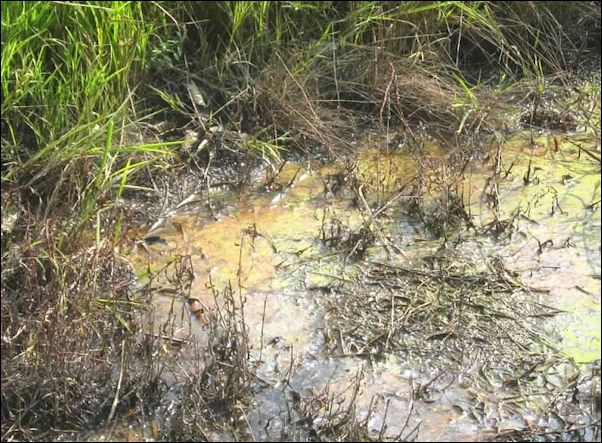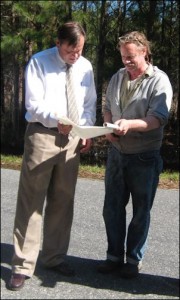by James A. Bacon
The Virginia Department of Transportation’s road maintenance program in Mathews County, you could say, has driven into a ditch. Over the years, VDOT has failed to properly maintain roadside ditches in the county, with the consequence that many now fail in their function of draining water into the tributaries of the Chesapeake Bay, contends Carol J. Bova, community activist and author of “Drowning a County,” published this year.
The repercussions of inadequate drainage are surprisingly far-reaching, according to Bova. When roads block natural drainage into rivers and streams, water builds up in land that once was dry, inundating and harming forests and septic systems. Ill-maintained ditches create standing water that breeds mosquitoes and allows the build-up of sometimes-toxic cyanobacteria. Stagnant ditch water also accumulates muck and invites invasive species. Receiving waters lose a source of oxygen-rich rainwater, and marshes lose a source of sediment that allow them to survive sea-level rise. Most counter-productively of all, inundation of soil around the roads accelerates the deterioration of VDOT-maintained roadbeds. The cost of poor maintenance is silent but extensive.
Bova and fellow activist G.C. Morrow have led a campaign to clean up the ditches of Mathews County but have encountered stiff bureaucratic resistance from VDOT, they say. The transportation agency contends that the problem isn’t the quality of roadside ditches. Mathews County is too flat to drain, and inundation is increasing because of sea level rise.
Bova wrote the book to dispute those and other VDOT “myths” regarding drainage. In the process, she has exposed various institutional failings, such as the inaccuracy of map data in Virginia’s Geographic Information Systems and the failure of VDOT to maintain accurate records regarding the location of drainage easements. “Drowning a County” is a marvelous example of what one or two determined citizens can accomplish.
In this post dedicated to Bova’s book, I am telling only one side of the story — I did not contact VDOT for a response. However, it seems undeniable that she has highlighted a major problem not only for the gently sloping Mathews County but for counties across Virginia’s flat Tidewater region, and even in its piedmont and mountain country. Says Bova: “VDOT’s refusal to accept responsibility for drainage” extends across the state.
Having lived in many places around the country, Bova moved to Mathews County in 2004 after her husband died. Mathews, she said, “is the most idyllic spot to live,” and it helped her heal from her grief. As she got more involved in the community, she noticed a variety of problems — failing septic systems, dying timber crops, a flooding high school ball field — that could be traced to the breakdown of the drainage system.
Before VDOT took over state roads nearly a century ago, Mathews County had a network of dirt roads and grass-lined ditches to accommodate the natural hydrology in which rain water either seeped into local aquifers or drained into creeks, streams, marshes and other “receiving waters.” The disruption of that system is evident to anyone who actually lives there. Bova connected with Morrow, a long-time Mathews resident, whose family has lived there for 300 years. Morrow knew the county’s history, geography and people. “He’s walked every foot of ditch in Mathews County,” she says. She complemented his in-depth local knowledge with documentary and online research.
Some counties can plausibly blame excess development for flooding and inundation; building roads, parking lots and other impermeable surface creates runoff and aggravates local flooding. That’s not the case in Mathews, where in 2010 the U.S. Census recorded fewer than 9,000 inhabitants — 46 more than in 1910. U.S. Department of Agriculture statistics show only 55 farms with 4,600 acres of land, compared to 1,387 farms in 1910 with 43,000 acre of land. Most of that farmland has reverted to forest.
Mathews may be one of the flattest counties in Virginia but that doesn’t mean its waters don’t drain. At one time, there were dry areas where people built houses, cleared farms and raised timber. Now that places are inundated. VDOT’s response is that Mathews is sinking into the sea, either through rising sea levels or subsidence of the tectonic plate. Bova disputes that claim with technical arguments, the merits of which few readers are informed enough to judge. However, there is no question that she has done her research. She has delved into the history of Virginia’s hydrology maps and documented the institutional inertia that perpetuates flaws and errors including the failure to take into account dramatic shoreline changes caused by storms and hurricanes or to reflect new scientific knowledge. Because Mathews lies at the impact point of the giant meteor that created the Chesapeake Bay, for instance, its geology, sub-soils, aquifers and drainage patterns are different than those of neighboring counties. But that insight, which dates to the 1980s, has yet to inform official water supply plans.
VDOT seems unwilling to consider the possibility, according to Bova, that its ditches may be to blame for the inundation and flooding. Yet the uneven condition of the ditches, culverts and other drainage infrastructure is beyond dispute. Bova and fellow citizens have thoroughly documented the blocked culverts and fetid waters along county roads in photographs that can be viewed on Facebook and in Shutterfly.
The fact is, says Bova, VDOT has failed to invest in proper drainage maintenance. The problem runs deeper than an unwillingness to allocate funds.
According to VDOT staff in Saluda, many old road plans have been lost or damaged, and some plans have been discarded for lack of storage space. … VDOT, as an institution, has lost track of what deeds it holds and even the location of some of the property given to the Commonwealth of Virginia for drainage by those deeds. …
VDOT’s near-total lack of knowledge of their deeded outfall drainage easements and a complete denial of responsibility for their maintenance has contributed to flooded roadside ditches, woods and property.
In theory, the remedy is simple, according to Bova. VDOT must restore the natural drainage patterns in Mathew County by opening its pipes and cleaning its ditch channels. Whether VDOT has the institutional wherewithal and political will to do so is another matter entirely.





